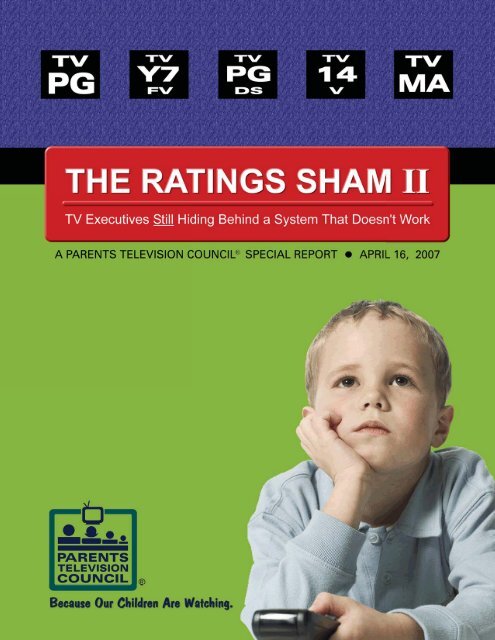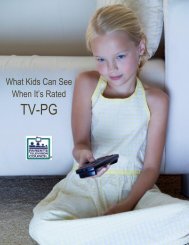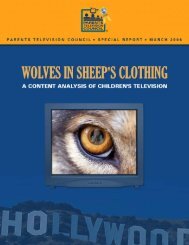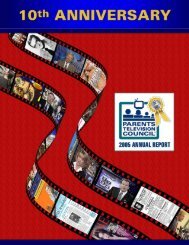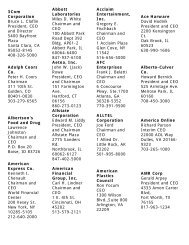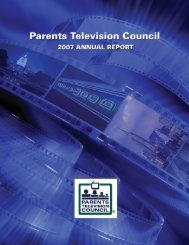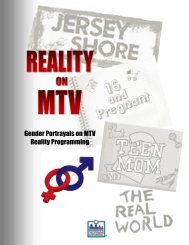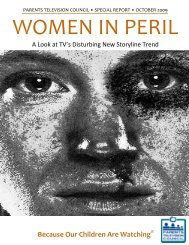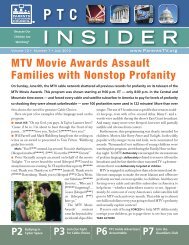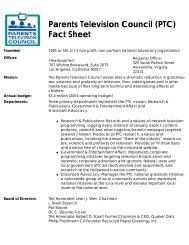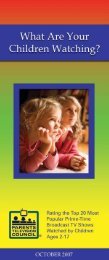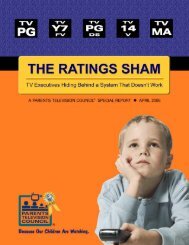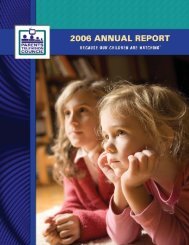The Ratings Sham II - Parents Television Council
The Ratings Sham II - Parents Television Council
The Ratings Sham II - Parents Television Council
You also want an ePaper? Increase the reach of your titles
YUMPU automatically turns print PDFs into web optimized ePapers that Google loves.
PARENTS TELEVISION COUNCIL<br />
L. Brent Bozell <strong>II</strong>I<br />
Founder<br />
Tim Winter<br />
President<br />
Mark Barnes<br />
Senior Consultant<br />
Melissa Caldwell<br />
Senior Director of Programs<br />
John Rattliff<br />
Director of Research<br />
Christopher Gildemeister<br />
Senior Editor<br />
Christopher Laurenzano<br />
Research Assistant<br />
Casey Williams<br />
Content Manager<br />
Aubree Bowling<br />
Senior Entertainment Analyst<br />
Caroline Schulenburg, Josh Shirlen,<br />
Joseph Bozell, Katherine Kuhn and Keith White<br />
Entertainment Analysts<br />
Glen Erickson<br />
Manager of Advertiser Programs<br />
Dan Isett<br />
Director of Corporate & Government Affairs<br />
Christiana Hills<br />
Director of Marketing &<br />
Grassroots Communications<br />
Tod Steward<br />
Director of Marketing for<br />
Membership Expansion<br />
Gavin McKiernan<br />
National Grassroots Director<br />
Kevin Granich<br />
Assistant to the Grassroots Director<br />
Regina Tercero<br />
Director of Finance & Administration<br />
Julie Feuerbacher<br />
Director of Development<br />
Robert Shear<br />
Resource Development Manager<br />
Marty Waddell<br />
Eastern Regional Development Representative<br />
Dan Bodwell<br />
Western Regional Development Representative<br />
Tracy Ferrell<br />
Development Assistant<br />
Larry Irvin<br />
Development Associate<br />
Jane Dean<br />
Office & Graphics Admin.<br />
Michelle Curtis, James Maxon, Andrew Bowser,<br />
Mayra Vargas and Gary Coby<br />
Interns<br />
TABLE OF CONTENTS<br />
Executive Summary ............................. 1<br />
Introduction ......................................... 3<br />
<strong>The</strong> <strong>Ratings</strong> System .............................. 5<br />
Study Parameters & Methodology ..... 5<br />
Overview of Major Findings ............... 6<br />
Network-by-Network Analysis<br />
and Examples .................................. 7<br />
Conclusion ......................................... 15<br />
About the PTC .................................... 16<br />
FOR MEDIA INQUIRIES<br />
PLEASE CONTACT<br />
Kelly Oliver<br />
CRC Public Relations<br />
(703) 683-5004<br />
PTC’S HOLLYWOOD HEADQUARTERS<br />
707 Wilshire Boulevard, Suite 2075<br />
Los Angeles, CA 90017 • (213) 629-9255<br />
<strong>The</strong> PTC is a 501(c)(3) nonprofit research<br />
and education foundation.<br />
© Copyright 2007 – <strong>Parents</strong> <strong>Television</strong> <strong>Council</strong>
A PARENTS TELEVISION COUNCIL SPECIAL REPORT • APRIL 16, 2007<br />
THE RATINGS SHAM <strong>II</strong><br />
TV Executives Still Hiding Behind a <strong>Ratings</strong> System That Doesn’t Work<br />
EXECUTIVE SUMMARY<br />
This is the <strong>Parents</strong> <strong>Television</strong> <strong>Council</strong>’s fifth report<br />
examining the television ratings system. <strong>The</strong> TV ratings<br />
include guidelines for age-appropriateness (TV-Y, TV-<br />
Y7, TV-G, TV-PG, TV-14, and TV-MA) and content<br />
descriptors to indicate the presence of specific types of<br />
content (“S” for sexual content, “V” for violence, “L” for<br />
coarse language, and “D” for suggestive dialogue). This<br />
ratings system was voluntarily adopted by the television<br />
industry in the mid-‘90s under the threat of government<br />
regulation due to growing public concerns about TV<br />
content.<br />
Since the ratings were introduced, at least half<br />
a dozen studies conducted by the <strong>Parents</strong> <strong>Television</strong><br />
<strong>Council</strong> and others have documented persistent<br />
problems with the application of the TV ratings. <strong>The</strong>se<br />
problems stem from how the ratings were originally<br />
conceived and executed, to wit, there are no guidelines<br />
dictating how they should be applied and each network<br />
rates its own programs. During the same period, PTC<br />
studies have reported a dramatic increase in both the<br />
frequency and explicitness of sexual content, violence<br />
and foul language on prime time broadcast television.<br />
Public opinion surveys taken since the adoption of the<br />
TV ratings have also documented growing discontent<br />
over TV content and unfamiliarity with the ratings and<br />
V-Chip.<br />
<strong>The</strong> TV ratings warrant close scrutiny because<br />
the entertainment industry is fighting a multi-million<br />
dollar battle in the courts of law and public opinion<br />
against the Federal Communications Commission and<br />
federal broadcast decency laws. <strong>The</strong> major broadcast<br />
networks have filed suit in federal court to overturn the<br />
decency law, arguing that the ratings and V-Chip have<br />
rendered the law obsolete. In addition, Hollywood is<br />
spending a combined $550 million on public service<br />
announcements to educate consumers and parents<br />
about the TV ratings and V-Chip.<br />
Madison Avenue also looks to the TV ratings<br />
system for guidance. Many corporate advertisers,<br />
particularly those which market or sell family products<br />
and services, rely on a program’s ratings when deciding<br />
whether or not to sponsor that program.<br />
<strong>The</strong> PTC set out to discover whether the TV<br />
ratings are reliably and consistently alerting parents<br />
to potentially objectionable content on prime time<br />
broadcast television (which still captures the largest<br />
audience of young viewers). <strong>The</strong> PTC examined<br />
all prime time entertainment programming on the<br />
six broadcast networks (ABC, CBS, Fox, NBC, CW,<br />
and MyNetworkTV) during the November 2006 and<br />
February 2007 sweeps periods for a total of 546 hours<br />
of programming on 608 individual programs. Sports<br />
and news programs were not included in this analysis.<br />
Since 99% of the programs were rated either TV-PG<br />
(48%)or TV-14 (51%), the analysis focused primarily on<br />
quantifying sexual content (verbal and visual), violence,<br />
and foul language and the presence (or absence) of<br />
corresponding content descriptors.<br />
<strong>The</strong> PTC found that content descriptors are<br />
not being consistently used by any of the broadcast<br />
networks during prime time viewing hours. Twothirds<br />
(67%) of the shows reviewed for this analysis<br />
containing potentially offensive content lacked one or<br />
more of the appropriate content descriptors.<br />
Other findings include:<br />
✔ 54% of shows containing suggestive dialogue<br />
lacked the “D” descriptor.<br />
✔ 63% of shows containing sexual content lacked<br />
the “S” descriptor.<br />
✔ 42% of shows containing violence lacked the<br />
“V” descriptor.<br />
✔ 44% of shows containing foul language lacked<br />
the “L” descriptor.<br />
✔ On ABC, 100% of the TV-14 rated programs<br />
lacked one or more descriptors.<br />
✔ 92% of NBC’s TV-14 rated programs lacked one<br />
or more descriptors.<br />
✔ On CBS, 73% of the TV-14 rated programs<br />
containing sexual content lacked the “S”<br />
descriptor.<br />
✔ None of the programs included in this analysis<br />
received a TV-MA rating, meaning all programs<br />
were deemed appropriate by the networks to be<br />
viewed by a child as young as 14, including (for<br />
example) an episode of C.S.I. Miami in which<br />
a woman died of asphyxiation during an oral<br />
rape.
2 THE RATINGS SHAM <strong>II</strong>: TV Executives Still Hiding Behind a System That Doesn’t Work • <strong>Parents</strong> <strong>Television</strong> <strong>Council</strong> • APRIL 16, 2007<br />
<strong>The</strong> networks’ premise that the decency laws<br />
are outmoded in light of new technologies is entirely<br />
false, as this study proves. <strong>The</strong> ratings system is a<br />
sham meant to keep Congress at bay while Hollywood<br />
continues to pump more and more of its toxic content<br />
into America’s homes.<br />
A new Zogby survey indicates that fewer than 15%<br />
of consumers are using the V-Chip. One likely reason<br />
for this abysmal adoption rate<br />
is that parents realize what the<br />
networks don’t want to admit —<br />
that the V-Chip doesn’t work.<br />
<strong>The</strong> V-Chip allows parents<br />
to block channels based either<br />
on the age-based ratings (and<br />
since virtually all programs during<br />
prime time are rated either PG<br />
or TV-14, blocking programs<br />
based on the age ratings would<br />
immediately disqualify 50-99%<br />
of all prime time broadcast<br />
programming) or based on<br />
the content descriptors, which<br />
are inaccurate two-thirds of<br />
the time. <strong>The</strong> V-Chip can not<br />
be relied upon to consistently<br />
<strong>The</strong> networks’ premise<br />
that the decency laws are<br />
outmoded in light of new<br />
technologies is entirely false,<br />
as this study proves.<br />
<strong>The</strong> ratings system is a sham<br />
meant to keep Congress<br />
at bay while Hollywood<br />
continues to pump more and<br />
more of its toxic content into<br />
America’s homes.<br />
block offensive programs because parents can not<br />
rely on the ratings to correctly identify problematic<br />
content.<br />
Clearly, the TV ratings and the V-Chip are<br />
inadequate for protecting children and families from<br />
offensive content. Congress and the courts should not<br />
be swayed by Hollywood’s argument that the existing<br />
decency laws are no longer needed because of these<br />
technologies. <strong>The</strong> FCC must<br />
continue to vigorously enforce<br />
broadcast decency laws, and<br />
the American people must<br />
continue to hold the networks<br />
accountable for how they use<br />
the publicly-owned broadcast<br />
airwaves. <strong>The</strong> networks are<br />
perpetrating a fraud on the<br />
advertising community as well<br />
by under-rating programs so as<br />
to not scare-off advertisers.<br />
Advertisers, the Congress,<br />
the courts, and — most<br />
importantly — the American<br />
public must not be fooled when<br />
the fox once again asks us to<br />
trust it to guard the henhouse.<br />
BECAUSE OUR CHILDREN ARE WATCHING. <br />
WWW.PARENTSTV.ORG ®
THE RATINGS SHAM <strong>II</strong>: TV Executives Still Hiding Behind a System That Doesn’t Work • <strong>Parents</strong> <strong>Television</strong> <strong>Council</strong> • APRIL 16, 2007 3<br />
THE RATINGS SHAM <strong>II</strong><br />
TV Executives Still Hiding Behind a <strong>Ratings</strong> System That Doesn’t Work<br />
APRIL 16, 2007 • BY KATHERINE KUHN<br />
I. INTRODUCTION<br />
On June 15 th 2006 President George W. Bush<br />
signed into law the Broadcast Decency Enforcement<br />
Act which gave the Federal Communications<br />
Commission (FCC) the authority to impose meaningful,<br />
punitive fines against broadcasters who violate federal<br />
laws barring the airing of indecent or profane material<br />
during certain hours of the day. For months before<br />
the bill was passed, Hollywood lobbied against the<br />
fine increase, insisting that the existing TV ratings<br />
and blocking technologies were sufficient to protect<br />
children from inappropriate content.<br />
This was hardly new or surprising behavior.<br />
Since the 1950s social scientists have studied and<br />
documented the harmful effects of exposure to media<br />
sex and violence on impressionable children. Every<br />
time the entertainment industry comes under fire<br />
for producing entertainment products saturated in<br />
sex, foul language and violence, industry executives<br />
scurry to offer a solution that will stall Congressional<br />
intervention. Concerns about sex and profanity in<br />
the movies in the mid-‘60s prompted the Motion<br />
Picture Association of America (MPAA) to offer up an<br />
independent age-based ratings system as the solution,<br />
thus appeasing lawmakers without forcing the movie<br />
industry to change their product.<br />
Concerns about TV content in the mid ‘90s<br />
led to a series of Congressional hearings and threats<br />
of regulation. Rather than submit to governmentimposed<br />
guidelines, TV executives announced they<br />
would voluntarily adopt an age-based ratings system,<br />
similar to that employed by the MPAA to rate films,<br />
to inform parents about a program’s suitability<br />
for young viewers. 1 Used in conjunction with the<br />
V-Chip, the ratings were meant to help parents block<br />
objectionable content from coming into their home.<br />
This calculated ploy was dismissed by the late George<br />
Gerbner, a leading researcher on the effects of violent<br />
entertainment on children, as “a delaying tactic that’s<br />
intended to alleviate the pressure from Congress and<br />
the American public.” 2<br />
<strong>The</strong> industry’s self-regulation regime was, as<br />
many expected it would be, an utter failure. Content<br />
has gotten measurably worse since the introduction<br />
of the TV ratings. <strong>The</strong> TV ratings have emboldened<br />
broadcasters to insert more frequent and more<br />
graphic sex, violence, and foul language into programs<br />
because they can now claim that parents were warned<br />
about the content beforehand. Until 2004 (when it was<br />
publicly embarrassed by the PTC) NBC refused to even<br />
use the content descriptors that would allow a parent<br />
to block out objectionable content on that network.<br />
<strong>The</strong> 2004 Super Bowl received only a PG rating, leaving<br />
parents unprepared for the Janet Jackson striptease that<br />
occurred during the halftime show.<br />
<strong>The</strong> TV ratings warrant close scrutiny because the<br />
entertainment industry is fighting a multi-million dollar<br />
battle in the courts of law and public opinion against the<br />
FCC and federal broadcast decency laws. <strong>The</strong> major<br />
broadcast networks are now suing in federal court to<br />
overturn the decency law, arguing that the ratings and<br />
V-Chip have made it obsolete.<br />
Hollywood is spending a combined $550 million<br />
on public service announcements ostensibly designed<br />
to educate parents about the V-Chip and TV ratings.<br />
But if the goal was to increase awareness and<br />
usage of the V-Chip, then the campaign has failed.<br />
Results from a Zogby International poll taken in March<br />
2007 indicate that even though the vast majority (79%)<br />
of Americans think there is too much sex, violence,<br />
and coarse language on television, most (88%) are still<br />
not using the V-Chip to block unwanted content, and<br />
only 8% were able to correctly identify the content<br />
descriptors, even when provided with the correct<br />
answer as part of a multiple choice question.
4 THE RATINGS SHAM <strong>II</strong>: TV Executives Still Hiding Behind a System That Doesn’t Work • <strong>Parents</strong> <strong>Television</strong> <strong>Council</strong> • APRIL 16, 2007<br />
Even if the V-Chip and TV ratings were universally<br />
understood, how useful would they really be?<br />
In the years immediately following the<br />
introduction of the ratings system, the PTC issued<br />
a series of reports evaluating the effectiveness and<br />
accuracy of the new system. Those reports showed that<br />
the new ratings were often inaccurate and unreliable.<br />
Every broadcast network has had problems with the<br />
consistent application of content descriptors.<br />
Are the networks doing any better now? This<br />
study, the fifth that the PTC has issued, seeks to<br />
discover whether the networks are doing a better job<br />
of rating their programs than they did in the late ‘90s.<br />
1. Content descriptors (“D” for sexually suggestive dialogue,<br />
“L” for vulgar language, “S” for sexual situations, and<br />
“V” for violence) were added after complaints that the<br />
age-based ratings were too vague.<br />
2. Gerbner’s cynicism was well founded. Two years earlier,<br />
when TV violence was a major topic in Congress, the<br />
networks volunteered to use parental advisories. <strong>The</strong>n,<br />
when the furor died down, the networks announced<br />
that they had not found any programs violent enough to<br />
merit an advisory.
THE RATINGS SHAM <strong>II</strong>: TV Executives Still Hiding Behind a System That Doesn’t Work • <strong>Parents</strong> <strong>Television</strong> <strong>Council</strong> • APRIL 16, 2007 5<br />
<strong>II</strong>. THE RATING SYSTEM<br />
<strong>The</strong>re are six categories in the television ratings<br />
system. Two designations, TV-Y and TV-Y7, apply only<br />
to children’s programs, most of which air weekday<br />
afternoons, on Saturday mornings, or on youthoriented<br />
cable networks.<br />
<strong>The</strong> primary ratings used for prime time shows<br />
are as follows. (<strong>The</strong> following definitions come from<br />
the FCC’s website www.fcc.gov/parents/parent_<br />
guide.html.)<br />
TV-G:<br />
“Although this rating does not signify a program<br />
designed specifically for children, most parents<br />
may let younger children watch this program<br />
unattended. It contains little or no violence, no<br />
strong language, and little or no sexual dialogue<br />
or situations.”<br />
TV-PG:<br />
“Many parents may want to watch it with their<br />
younger children. <strong>The</strong> theme itself may call for<br />
parental guidance and/or the program contains<br />
one or more of the following: moderate violence<br />
(V), some sexual situations (S), infrequent coarse<br />
language (L), or some suggestive dialogue (D).”<br />
TV-14:<br />
“<strong>Parents</strong> are strongly urged to exercise greater<br />
care in monitoring this program and are cautioned<br />
against letting children under the age of 14<br />
watch unattended. This program contains one or<br />
more of the following: intense violence (V), intense<br />
sexual situations (S), strong coarse language (L),<br />
or intensely suggestive dialogue (D).<br />
<strong>II</strong>I. Study Parameters and<br />
Methodology<br />
<strong>The</strong> PTC examined all prime time 3 entertainment<br />
programming on the six broadcast networks (ABC,<br />
CBS, Fox, NBC, CW, and MyNetworkTV) during the<br />
November 2006 and February 2007 sweeps periods,<br />
for a total of 541 hours of programming on 608<br />
individual programs. Sports and news programs were<br />
not included in this analysis.<br />
<strong>The</strong> suggestive dialogue was separated into two<br />
categories: references to a specific sexual act and<br />
sexual innuendo. References to a specific act included,<br />
but were not limited to: intercourse, bestiality, bodily<br />
functions related to a sexual act (e.g. ejaculation,<br />
erection, orgasm, etc.), pornography, anatomical<br />
references, and other sex-related references.<br />
Language was separated into numerous<br />
categories: Curses and Intensives (hell and damn<br />
and the like); Offensive Epithets and Racial Slurs;<br />
Scatological Language; Sexually Suggestive Language;<br />
Vulgar Slang; Censored Language, and Euphemisms<br />
for obscenities. <strong>The</strong> PTC also tracked separately the<br />
original “Seven Dirty Words” on which the FCC v<br />
Pacifica case was based.<br />
Since 99% of the programs were rated either<br />
TV-PG (48%)or TV-14 (51%), 4 the analysis focused<br />
primarily on quantifying sexual content (verbal and<br />
visual), violence and foul language and the presence<br />
(or absence) of corresponding content descriptors.<br />
3. 8:00-11:00 p.m. ET Monday-Saturday, 7:00-11:00 p.m.<br />
ET Sunday<br />
4. None of the analyzed programs were rated TV-MA.<br />
<strong>The</strong> TV-MA rating indicates that a program should not<br />
be viewed by a child under the age of 18.<br />
<strong>The</strong> sixth rating is TV-MA, which no program<br />
received during our study period. TV-MA designates<br />
shows “specifically designed to be viewed by adults<br />
and [which] therefore may be unsuitable for children<br />
under 17. [<strong>The</strong>y] may contain mature themes, profane<br />
language, graphic violence and explicit sexual<br />
content.” TV-MA is applied almost exclusively to latenight<br />
and cable fare.<br />
Within the study period examined by the PTC,<br />
one program was unrated, 5 were rated TV-G, 294<br />
were rated TV-PG, and 308 were rated TV-14. None<br />
of the programs included in this analysis received a<br />
TV-MA rating, meaning all programs were deemed<br />
appropriate by the networks to be viewed by a child<br />
as young as 14.
6 THE RATINGS SHAM <strong>II</strong>: TV Executives Still Hiding Behind a System That Doesn’t Work • <strong>Parents</strong> <strong>Television</strong> <strong>Council</strong> • APRIL 16, 2007<br />
IV. Overview of Major Findings<br />
☛ Two-thirds (67%) of the shows reviewed for this<br />
analysis containing potentially offensive content<br />
lacked one or more of the appropriate content<br />
descriptors.<br />
☛ 54% of shows containing suggestive dialogue lacked<br />
the “D” descriptor.<br />
☛ 63% of shows containing sexual content lacked the<br />
“S” descriptor.<br />
☛ 42% of shows containing violence lacked the “V”<br />
descriptor.<br />
☛ 44% of shows containing foul language lacked the<br />
“L” descriptor.<br />
☛ 47% of shows lacking the “L” descriptor used one or<br />
more of the original “Seven Dirty Words,” on which<br />
the FCC v. Pacifica case was based.<br />
☛ 40% of all TV-G shows examined were lacking one<br />
or more descriptor.<br />
☛ 59% of all TV-PG shows examined were lacking one<br />
or more descriptor.<br />
☛ 79% of all TV-14 shows lacked one or more<br />
descriptor.<br />
ABC<br />
● Of the 63 TV-PG shows, 73% were missing the<br />
necessary content descriptors.<br />
● <strong>The</strong> single not-rated (NR) show had content that<br />
would have warranted the “D,” “V,” and “L”<br />
descriptor.<br />
● 100% of the 31 TV-14 shows lacked one or more of<br />
the necessary descriptors.<br />
● 30% of the TV-PG shows and 58% of the TV-14 shows<br />
with suggestive dialogue lacked the “D” descriptor.<br />
● 32% of TV-PG-rated shows contained sexual<br />
behavior but lacked the “S” descriptor and 65% of<br />
TV-14 rated shows contained sexual behavior but<br />
lacked the “S” descriptor.<br />
● 26% of TV-PG shows contained violent content but<br />
lacked the “V” descriptor, 48% of TV-14 rated shows<br />
had violent content but lacked the “V” descriptor.<br />
● 24% of TV-PG shows had foul language but lacked<br />
the “L” descriptor, 87% of TV-14-rated shows had<br />
foul language but lacked the “L” descriptor.<br />
CBS<br />
● Of the 89 TV-PG rated shows, 54% lacked one or<br />
more of the necessary content descriptors.<br />
● Of the 53 TV-14 rated shows 83% lacked one or<br />
more of the necessary content descriptors.<br />
● Of the 22 TV-14 rated shows with sexual behavior,<br />
73% lacked the “S” descriptor.<br />
● 55% of the TV-14 rated shows lacked the “L”<br />
descriptor.<br />
Fox<br />
● 70% of the TV-PG shows lacked one or more<br />
necessary content descriptors.<br />
● 59% of the TV-14 shows lacked one or more<br />
necessary content descriptors.<br />
NBC<br />
● 92% of TV-14 shows lacked one or more content<br />
descriptors. 55% lacked the necessary “V” descriptor,<br />
and 70% lacked the necessary “L” descriptor.<br />
● Of the 59 TV-14 shows that lacked the “L” descriptor,<br />
“son of a bitch” was used in 23 shows once or more.<br />
● One episode of Friday Night Lights had 14 instances<br />
of profanity but no “L” descriptor. <strong>The</strong> following<br />
week’s episode was rated TV-PG L, but contained<br />
only 9 instances of profanity.<br />
● One episode of Medium had ten instances of<br />
profanity and no “L” descriptor. Two weeks before,<br />
an episode of the same program had three instances<br />
of profanity and was rated TV-14 L.<br />
CW<br />
● 89% of the TV-14 shows lacked one or more<br />
necessary descriptors.<br />
● Of the 19 TV-14 shows with sexual content, 53%<br />
lacked the “S” descriptor.<br />
● 42% of the TV-PG shows with foul language lacked<br />
the “L” descriptor.<br />
● On the CW, one of the five TV-G rated shows<br />
contained the word “ass,” which would warrant at<br />
least a TV-PG if not a TV-PG with the “L” descriptor.<br />
MyNetworkTV<br />
● MyNetworkTV does by far the best job in implementing<br />
content descriptors, with the exception of the “D”<br />
descriptor. 46% of the TV-14 shows lack the “D”<br />
descriptor, 14% lack the “S” descriptor, 1% lack the<br />
“V” descriptor, and 8% lack the “L” descriptor.
THE RATINGS SHAM <strong>II</strong>: TV Executives Still Hiding Behind a System That Doesn’t Work • <strong>Parents</strong> <strong>Television</strong> <strong>Council</strong> • APRIL 16, 2007 7<br />
V. Network-by-Network Analysis and Examples<br />
ABC<br />
Totals: 94 hours, 95 shows<br />
TV-G: 0<br />
TV-PG: 63 shows<br />
LANGUAGE<br />
42 shows with obscenities<br />
16 (38%) without “L” descriptor<br />
1 with “L” descriptor but no foul language<br />
VIOLENCE<br />
29 shows with violence<br />
22 (76%) without “V” descriptor<br />
1 with “V” descriptor but no violence<br />
SEX<br />
31 shows with sexual behavior<br />
26 (84%) without “S” descriptor<br />
0 with “S” descriptor but no sex<br />
DIALOGUE<br />
33 shows with suggestive dialogue<br />
15 (45%) without “D” descriptor<br />
5 with “D” descriptor but no suggestive dialogue<br />
TV-14: 31 shows<br />
LANGUAGE<br />
30 shows with obscenities<br />
27 (90%) without “L” descriptor<br />
0 with “L” descriptor but no obscenities<br />
VIOLENCE<br />
27 shows with violence<br />
15 (56%) without “V” descriptor<br />
0 with “V” descriptor but no violence<br />
SEX<br />
25 shows with sexual behavior<br />
20 (80%) without “S” descriptor<br />
0 with “S” descriptor but no sexual behavior<br />
DIALOGUE<br />
25 shows with suggestive dialogue<br />
18 (72%) without “D” descriptor<br />
0 with “D” descriptor but no suggestive dialogue<br />
NR: 1 show<br />
1 show with obscenities, 1 without “L”<br />
1 show with violence, 1 without “V”<br />
0 shows with sexual behavior<br />
1 show with suggestive dialogue, 1 without “D”<br />
BY HOUR:<br />
7:00 ..........G: 0 ......PG: 5.........14: 0 ........ NR: 1<br />
8:00 ..........G: 0 ......PG: 33 ......14: 1 ........ NR: 0<br />
9:00 ..........G: 0 ......PG: 11 ......14: 18 ..... NR: 0<br />
10:00 ..........G: 0 ......PG: 14 ......14: 12 ..... NR: 0<br />
MISSING DESCRIPTORS<br />
DIALOGUE<br />
Grey’s Anatomy (TV-14) 9:00 p.m. ET<br />
Nancy: “So tell me about this slutty girl. Fine, slutty<br />
intern.”<br />
Derek: “It was the slutty part that I had a problem<br />
with.”<br />
Later in the conversation:<br />
Nancy: “Oh come on, everybody sleeps with Mark.<br />
It’s practically a rite of passage.”<br />
Nancy is describing how sleeping with Derek’s best<br />
friend is something that every woman does.<br />
<strong>The</strong>re were eight other instances of sexual dialogue<br />
that would warrant a “D” descriptor.<br />
SEX<br />
What About Brian? (TV-PG DL) 10:00 p.m. ET<br />
David, Jimmy, Adam, and Brian are at a strip club.<br />
<strong>The</strong>re are scantily clad strippers dancing suggestively<br />
on stage. <strong>The</strong> song in the background is as follows:<br />
“Can I get freaky freaky with you? Can I get freaky<br />
freaky with you? Hell yeah.”<br />
While the episode was correctly labeled with a “D”<br />
and “L,” it should have also received an “S” for the<br />
sexual content.
8 THE RATINGS SHAM <strong>II</strong>: TV Executives Still Hiding Behind a System That Doesn’t Work • <strong>Parents</strong> <strong>Television</strong> <strong>Council</strong> • APRIL 16, 2007<br />
VIOLENCE<br />
Supernanny (TV-PG) 9:00 p.m. ET<br />
Combined, four episodes of Supernanny had 47<br />
scenes of violence with 104 incidents of violence<br />
within those scenes. Those scenes depict children<br />
misbehaving and undermining their parents by<br />
hitting, punching, biting, and kicking their siblings and<br />
parents. Although mild, this show should carry a “V”<br />
descriptor.<br />
FOUL LANGUAGE<br />
America’s Funniest Home Videos (TV-PG) 7:00 p.m. ET<br />
A clip sent in by a viewer depicts a man stripping on<br />
a chair in front of some women. <strong>The</strong> man shows his<br />
behind to the women which is blurred out. <strong>The</strong> host<br />
narrates the scene:<br />
Host: “This is a union jack [pause] ass.”<br />
CBS<br />
Totals: 124 hours, 142 shows<br />
TV-G: 0<br />
TV-PG: 89 shows<br />
LANGUAGE<br />
71 shows with obscenities<br />
14 (20%) without “L” descriptor<br />
9 with “L” descriptor but no obscenities<br />
VIOLENCE<br />
49 shows with violence<br />
20 (41%) without “V” descriptor<br />
0 with “V” descriptor but no violence<br />
SEX<br />
26 shows with sexual behavior<br />
23 (88%) without “S” descriptor<br />
1 with “S” descriptor but no sexual behavior<br />
DIALOGUE<br />
42 shows with suggestive dialogue<br />
16 (38%) without “D” descriptor<br />
4 with “D” descriptor but no suggestive dialogue<br />
TV-14: 53 shows<br />
LANGUAGE<br />
47 shows with obscenities<br />
29 (62%) without “L” descriptor<br />
1 with “L” descriptor but no obscenities<br />
VIOLENCE<br />
45 shows with violence<br />
9 (20%) without “V” descriptor<br />
1 with “V” descriptor but no violence<br />
SEX<br />
22 shows with sexual behavior<br />
16 (73%) without “S” descriptor<br />
0 with “S” descriptor but no sexual behavior<br />
DIALOGUE<br />
28 shows with suggestive dialogue<br />
16 (57%) without “D” descriptor<br />
1 with “D” descriptor but no suggestive dialogue
THE RATINGS SHAM <strong>II</strong>: TV Executives Still Hiding Behind a System That Doesn’t Work • <strong>Parents</strong> <strong>Television</strong> <strong>Council</strong> • APRIL 16, 2007 9<br />
BY HOUR:<br />
8:00 ..........G: 0 ......PG: 48 ......14: 3<br />
9:00 ..........G: 0 ......PG: 30 ......14: 23<br />
10:00 ..........G: 0 ......PG: 11 ......14: 27<br />
MISSING DESCRIPTORS<br />
DIALOGUE<br />
How I Met Your Mother (TV-14) 8:00 p.m. ET<br />
Ted complains that his girlfriend is too private and<br />
never tells him anything.<br />
Barney says to Ted: “Fine. You want to know what<br />
Robin’s secret is?”<br />
Ted: “You know?”<br />
Barney: “Of course I know. She couldn’t look at<br />
us, her face got flushed. That’s shame, my friend.<br />
Our friend Robin used to do porn…wait for it…<br />
ography.”<br />
Ted: “Yeah we didn’t have to wait for that. And it’s<br />
ridiculous.”<br />
Lily: “I don’t know, he could be right. She does<br />
have those fake orgasm noises down.”<br />
Ted: “Hey!”<br />
Lily: “What? <strong>The</strong> walls are thin.”<br />
Here the three friends are talking about Robin’s<br />
apparent pornographic past. <strong>The</strong>re are numerous<br />
sexual references within this scene to pornography<br />
and to sex itself. This episode had 11 instances of<br />
sexual dialogue with no “D” descriptor.<br />
SEX, LANGUAGE, VIOLENCE<br />
Criminal Minds (TV-14) 9:00 p.m. ET<br />
In this episode, the killer lures her victim into her<br />
apartment using a variety of sexual gestures. This<br />
episode should have an “S” descriptor. <strong>The</strong> language<br />
and the violence that accompanies the scenes<br />
warrant “L” and “V” descriptors.<br />
<strong>The</strong> killer lures an unsuspecting man to her<br />
apartment. <strong>The</strong> victim is under the impression that<br />
she is going to have sex with him. <strong>The</strong> scene opens<br />
with the killer passionately kissing her victim. Once<br />
they are in the killer’s apartment, she ties him up in<br />
bed. She then straddles him with a knife in hand and<br />
slashes his chest. <strong>The</strong> man begins to bleed.<br />
Man: “What the hell?!”<br />
Later in the scene:<br />
<strong>The</strong> killer is in bed with her victim. He is still tied<br />
up and now is covered in blood from where she cut<br />
him.<br />
Man: “You crazy bitch.”<br />
<strong>The</strong> FBI team then enters and points guns at the<br />
woman.<br />
VIOLENCE<br />
NCIS (TV-PG DL) 8:00 p.m. ET<br />
A woman is found nude covered only by a bedsheet.<br />
She is dead and has strangulation marks on her neck.<br />
This episode had seven scenes showing corpses with<br />
some scenes showing how the people died. <strong>The</strong><br />
episode received “D” and “L” descriptors but no “V.”<br />
<strong>The</strong> following episode of NCIS was rated TV-PG L<br />
but should have also received a “V.”<br />
Woman: “I was just using Tate to get even for this<br />
bitch’s blog!”<br />
In a flashback, we see a man being stabbed by a<br />
security guard.
10 THE RATINGS SHAM <strong>II</strong>: TV Executives Still Hiding Behind a System That Doesn’t Work • <strong>Parents</strong> <strong>Television</strong> <strong>Council</strong> • APRIL 16, 2007<br />
Fox<br />
Totals: 84.5 hours, 103 shows<br />
TV-G: 0<br />
TV-PG: 54 shows<br />
LANGUAGE<br />
39 shows with obscenities<br />
13 (33%) without “L” descriptor<br />
2 with “L” descriptor but no obscene language<br />
VIOLENCE<br />
28 shows with violence<br />
14 (50%) without “V” descriptor<br />
2 with “V” descriptor but no violence<br />
SEX<br />
24 shows with sexual behavior<br />
17 (71%) without “S” descriptor<br />
1 with “S” descriptor but no sexual behavior<br />
DIALOGUE<br />
27 shows with suggestive dialogue<br />
14 (52%) without “D” descriptor<br />
0 with “D” descriptor but no suggestive dialogue<br />
TV-14: 49 shows<br />
LANGUAGE<br />
45 shows with obscenities<br />
9 (20%) without “L” descriptor<br />
1 with “L” descriptor but no obscene language<br />
VIOLENCE<br />
42 shows with violence<br />
11 (26%) with “V” descriptor<br />
0 with “V” descriptor but no violence<br />
SEX<br />
25 shows with sexual behavior<br />
14 (56%) without “S” descriptor<br />
0 with “S” descriptor but no sexual behavior<br />
DIALOGUE<br />
30 shows with suggestive dialogue<br />
14 (47%) without “D” descriptor<br />
6 with “D” descriptor but no suggestive dialogue<br />
BY HOUR:<br />
8:00 ..........G: 0 ......PG: 32 ......14: 25<br />
9:00 ..........G: 0 ......PG: 22 ......14: 24<br />
MISSING DESCRIPTORS<br />
DIALOGUE<br />
<strong>The</strong> O.C. (TV-PG VL) 9:00 p.m. ET<br />
Taylor: “I’m afraid of his sensual powers. Ryan, the<br />
man is a sexual Jedi. Whatever he asks you to do,<br />
you do it. It doesn’t matter how depraved…”<br />
Ryan: “Ok, some people are trying to eat here,<br />
including me…”<br />
SEX, DIALOGUE<br />
America’s Most Wanted (TV-PG V) 9:00 p.m. ET<br />
<strong>The</strong> host explains how children in Cambodia are<br />
being used as sex slaves. <strong>The</strong>re are girls shown<br />
dancing suggestively. <strong>The</strong> host talks about how<br />
a man trains the slaves for sex when his wife or<br />
girlfriend does not want to have sex with him.<br />
American Dad (TV-14 L) 9:30 p.m. ET<br />
Steve’s grandfather tells him that every time Steve<br />
interrupts him while he’s talking, Steve’s penis is<br />
going to get smaller.<br />
Grandfather: “For every time you interrupt, your<br />
penis is getting shorter.”<br />
Later in the episode:<br />
Steve’s friend: “I can’t believe I’m giving you away<br />
on your wedding day...Oh seems like just yesterday<br />
you popped out of that box and I was planning to<br />
have sex with you... sunrise... sunset...”<br />
As this episode has sexually charged dialogue in<br />
several scenes, the show should have received a “D”<br />
in addition to the “L” descriptor it was given.<br />
VIOLENCE<br />
Family Guy (TV-14 DL) 9:00 p.m. ET<br />
A scene shows two men fighting in the park. One<br />
man gets slapped and falls to the ground. <strong>The</strong><br />
aggressor then continues to hit the fallen man until<br />
blood begins to drip from his nose.<br />
In another scene form the same episode, <strong>The</strong><br />
“Cheetoh’s Cheetah” snorts a line of cheese powder
THE RATINGS SHAM <strong>II</strong>: TV Executives Still Hiding Behind a System That Doesn’t Work • <strong>Parents</strong> <strong>Television</strong> <strong>Council</strong> • APRIL 16, 2007 11<br />
off a glass coffee table. He then smashes his hand<br />
into the table. He holds his hand up and there are<br />
shards of glass in it. Blood drips onto the floor.<br />
This episode contained multiple scenes of violence,<br />
which in most cases resulted in physical harm. This<br />
episode should have been given the “V” descriptor.<br />
LANGUAGE<br />
24 (TV-14 V) 9:00 p.m. ET<br />
Jack: “Take out the syringe! Do it! Now! Son of a<br />
bitch! You son of a bitch! Do you want to die?”<br />
NBC<br />
Totals: 109 hours, 119 shows<br />
TV-G: 0<br />
TV-PG: 35<br />
LANGUAGE<br />
9 shows with obscene language<br />
4 (44%) without “L” descriptor<br />
0 with “L” descriptor but no obscene language<br />
VIOLENCE<br />
3 shows with violence<br />
3 (100%) without “V” descriptor<br />
0 with “V” descriptor but no violence<br />
SEX<br />
3 shows with sexual behavior<br />
3 (100%) without “S” descriptor<br />
0 with “S” descriptor but no sexual behavior<br />
DIALOGUE<br />
7 shows with suggestive dialogue<br />
6 (86%) without “D” descriptor<br />
0 with “D” descriptor but no suggestive dialogue<br />
TV-14: 84<br />
LANGUAGE<br />
80 shows with obscene language<br />
59 (74%) without “L” descriptor<br />
0 with “L” descriptor but no obscene language<br />
VIOLENCE<br />
69 shows with violence<br />
46 (67%) without “V” descriptor<br />
0 with “V” descriptor but no violence<br />
SEX<br />
44 shows with sexual behavior<br />
26 (59%) without “S” descriptor<br />
0 with “S” descriptor but no sexual behavior<br />
DIALOGUE<br />
49 shows with suggestive dialogue<br />
27 (55%) without “D” descriptor<br />
6 with “D” descriptor but no suggestive dialogue
12 THE RATINGS SHAM <strong>II</strong>: TV Executives Still Hiding Behind a System That Doesn’t Work • <strong>Parents</strong> <strong>Television</strong> <strong>Council</strong> • APRIL 16, 2007<br />
BY HOUR:<br />
8:00 ..........G: 0 ......PG: 27 ......14: 16<br />
9:00 ..........G: 0 ......PG: 8.........14: 32<br />
10:00 ..........G: 0 ......PG: 0.........14: 36<br />
MISSING DESCRIPTORS<br />
LANGUAGE<br />
Friday Night Lights (TV-PG) 8:00 p.m. ET<br />
Assistant Coach: “People are a bunch of damn PC<br />
sons of bitches trying to get my damn job.”<br />
Coach: “I’m afraid it’s not just a bunch of sons of<br />
bitches.”<br />
Later in the conversation:<br />
Coach: “What I’m telling you is that it’s not too<br />
damn smart to be making generalizations.”<br />
This episode of Friday Night Lights had 14 instances<br />
of profanity and no “L” descriptor. <strong>The</strong> following<br />
week’s episode was rated TV-PG L and had 9<br />
instances of profanity.<br />
Medium (TV-14 V) 10:00 p.m. ET<br />
Girl: “I wish they would just catch the son of a<br />
bitch already. You’re damn right it’s scary.”<br />
This episode had ten instances of profanity and no<br />
“L” descriptor. Two weeks earlier, the 2/14/2007<br />
episode had three instances of profanity and was<br />
rated TV-14 L.<br />
In another scene:<br />
Elliot: “Living with a guy before marriage makes me<br />
feel too whorey.”<br />
Nurse: “You can live in separate states, but if you’re<br />
doing the nasty before you get married, your ass is<br />
going to burn.”<br />
Clearly this episode, which aired in the 9:00 hour,<br />
should have been given “S,” “D,” and “L” descriptors.<br />
<strong>The</strong> show had 11 instances of profanity, 11 instances<br />
of sexual dialogue, and one instance of sex.<br />
VIOLENCE<br />
Las Vegas (TV-14 SDL) 9:00 p.m. ET<br />
Sam: “I’m going to give you one more chance and<br />
then I’m going to have to kick your ass.”<br />
Sam grabs a woman by the neck and then slams her<br />
head into the back of a car seat repeatedly.<br />
Due to the violent nature of this scene, there<br />
should have been a “V” descriptor. <strong>The</strong>re were<br />
several other scenes in this episode where Sam was<br />
attempting to collect money and used violence to<br />
get her point across.<br />
DIALOGUE<br />
Scrubs (TV-14) 9:00 p.m. ET<br />
Dr. Cox: “You have a penis, or that’s what I think it<br />
is.”<br />
JD: “It’s a penis.”<br />
No “D” descriptor.<br />
SEX, DIALOGUE, LANGUAGE<br />
Scrubs (TV-14)<br />
Elliot and her boyfriend participate in a kinky sex<br />
game where each one gets into a cardboard box.<br />
<strong>The</strong>y make noises as if they are experiencing an<br />
orgasm and then emerge from their respective boxes.<br />
Elliot is shown in lingerie.
THE RATINGS SHAM <strong>II</strong>: TV Executives Still Hiding Behind a System That Doesn’t Work • <strong>Parents</strong> <strong>Television</strong> <strong>Council</strong> • APRIL 16, 2007 13<br />
CW<br />
Totals: 61.5 hours, 76 shows<br />
TV-G: 5<br />
LANGUAGE<br />
1 show with obscene language<br />
1 (100%) without “L” descriptor<br />
VIOLENCE<br />
0 shows with violence<br />
0 without “V” descriptor<br />
SEX<br />
0 shows with sexual behavior<br />
0 without “S” descriptor<br />
DIALOGUE<br />
1 show with suggestive dialogue<br />
1 (100%) without “D” descriptor<br />
TV-PG: 52<br />
LANGUAGE<br />
44 shows with obscene language<br />
22 (50%) without “L” descriptor<br />
0 with “L” descriptor but no obscene language<br />
VIOLENCE<br />
19 shows with violence<br />
7 (37%) without “V” descriptor<br />
0 with “V” descriptor but no violence<br />
SEX<br />
13 shows with sexual behavior<br />
10 (77%) without “S” descriptor<br />
0 with “S” but no sexual behavior<br />
DIALOGUE<br />
21 shows with suggestive dialogue<br />
8 (38%) without “D” descriptor<br />
5 with “D” descriptor but no suggestive dialogue<br />
TV-14: 19<br />
LANGUAGE<br />
18 shows with obscene language<br />
2 (11%) without “L” descriptor<br />
1 with “L” descriptor but no obscene language<br />
VIOLENCE<br />
13 shows with violence<br />
7 (54%) without “V” descriptor<br />
0 with “V” descriptor but no violence<br />
SEX<br />
17 shows with sexual behavior<br />
10 (59%) without “S” descriptor<br />
0 with “S” descriptor but no sexual behavior<br />
DIALOGUE<br />
15 shows with suggestive dialogue<br />
4 (27%) without “D” descriptor<br />
1 with “D” descriptor but no suggestive dialogue<br />
BY HOUR:<br />
7:00 ..........G: 0 ......PG: 4.........14: 0<br />
8:00 ..........G: 5 ......PG: 31 ......14: 4<br />
9:00 ..........G: 0 ......PG: 17 ......14: 15<br />
MISSING DESCRIPTORS<br />
LANGUAGE<br />
7th Heaven (TV-G) 8:00 p.m.ET<br />
Annie: “Oops, my ass.”<br />
While 7th Heaven almost always has the appropriate<br />
descriptors, this episode should have received a<br />
TV-PG rating with the “L” descriptor. If the TV rating<br />
guidelines outlined at the beginning of the report<br />
were followed, no TV-G show would have any strong<br />
language at all.<br />
VIOLENCE<br />
Everybody Hates Chris (TV-PG) 8:00 p.m. ET<br />
Caruso is punching a boy on the playground while<br />
his friends hold the boy down. Caruso asks Chris if<br />
he would like to hit the kid, too. Chris declines.<br />
Later in the episode:<br />
Caruso and his gang beat up Chris at school.<br />
While this may be comic violence, it should be given<br />
the “V” descriptor based on the fact that this bullying<br />
happens several times in the episode.<br />
SEX<br />
<strong>The</strong> Game (TV-14) 9:30 p.m. ET<br />
Kelly pole dances in front of Melanie and Tasha,<br />
showing them how to “please their man.”
14 THE RATINGS SHAM <strong>II</strong>: TV Executives Still Hiding Behind a System That Doesn’t Work • <strong>Parents</strong> <strong>Television</strong> <strong>Council</strong> • APRIL 16, 2007<br />
Tasha: “I’m not gay, but damn!”<br />
Later in the show:<br />
Melanie takes off her robe when she hears Derwin<br />
coming down the hall. She stands completely naked at a<br />
pole wearing high heels and dances. She is shown only<br />
from her shoulders up, implying that she is nude.<br />
Though this is a TV-14 show, because the theme<br />
of stripping and showing the act of stripping is<br />
prominent in this episode the “S” descriptor should<br />
have been applied.<br />
Everybody Hates Chris (TV-PG V) 8:00 p.m. ET<br />
Two men are shown in a strip club watching a girl<br />
on a pole dancing suggestively. She is scantily clad,<br />
wearing a short skirt, tight sweater, and stockings.<br />
This scene clearly illustrates strong sexual behavior<br />
that warrants the “S” descriptor.<br />
TV-14: 72<br />
LANGUAGE<br />
64 shows with obscene language<br />
6 (9%) without “L” descriptor<br />
2 with “L” descriptor but no obscene language<br />
VIOLENCE<br />
60 shows with violence<br />
1 (2%) without “V” descriptor<br />
12 with “V” descriptor but no violence<br />
SEX<br />
41 shows with sexual behavior<br />
10 (24%) without “S” descriptor<br />
13 with “S” descriptor but no sexual behavior<br />
DIALOGUE<br />
33 shows with suggestive dialogue<br />
33 (100%) without “D” descriptor<br />
0 with “D” descriptor but no suggestive dialogue<br />
My Network TV<br />
Totals: 73 hours, 73 shows<br />
TV-G: 0<br />
TV-PG: 1<br />
LANGUAGE<br />
1 show with obscene language<br />
1 (100%) without “L” descriptor<br />
0 with “L” descriptor but no obscene language<br />
VIOLENCE<br />
1 show with violence<br />
0 without “V” descriptor<br />
0 with “V” descriptor but no violence<br />
SEX<br />
1 show with sexual behavior<br />
0 without “S” descriptor<br />
0 with “S” descriptor but no sexual behavior<br />
BY HOUR:<br />
8:00 ..........G: 0 ......PG: 0.........14: 37<br />
9:00 ..........G: 0 ......PG: 1.........14: 35<br />
MISSING DESCRIPTORS<br />
DIALOGUE<br />
Watch Over Me (TV-14 SV) at the 9:00 hour<br />
Caitlin and Michael are in bed together. Michael<br />
straddles Caitlin while kissing her. He asks her,<br />
“…that [secret affair] doesn’t turn you on?”<br />
<strong>The</strong> rest of the episode centers around the<br />
characters’ sexual affairs. Michael is having an affair<br />
with Caitlin; Jack and Julia are having an affair while<br />
Jack is engaged to Natalie.<br />
This episode, for its focus on the sexual affairs<br />
warrants a “D” descriptor.<br />
DIALOGUE<br />
1 show with suggestive dialogue<br />
1 (100%) without “D” descriptor<br />
0 with “D” descriptor but no suggestive dialogue
THE RATINGS SHAM <strong>II</strong>: TV Executives Still Hiding Behind a System That Doesn’t Work • <strong>Parents</strong> <strong>Television</strong> <strong>Council</strong> • APRIL 16, 2007 15<br />
VI. Conclusion<br />
After the Janet Jackson Super Bowl debacle in<br />
2004, executives from the major broadcast networks<br />
were called before Congress to outline what steps<br />
they would take to prevent such occurrences from<br />
happening in the future. According to Broadcasting &<br />
Cable, “NBC said the FCC should review whether it<br />
should be enforcing any anti-indecency rules nowadays<br />
given that broadcast viewers have the option of using<br />
the V-Chip to block channels they don’t want coming<br />
into their homes.”<br />
<strong>The</strong> networks’ premise that the decency laws are<br />
outmoded in light of new technologies is entirely false,<br />
as this study proves. <strong>The</strong> ratings system is a sham<br />
meant to keep Congress at bay while Hollywood<br />
continues to pump more and more of its toxic content<br />
into America’s homes.<br />
A new Zogby survey indicates that fewer than<br />
15% of consumers are using the V-Chip, probably<br />
because they realize what the networks don’t want to<br />
admit – that the V-Chip doesn’t work.<br />
<strong>The</strong> V-Chip allows parents to block channels<br />
based either on the age-based ratings (and since 99%<br />
of all programs during prime time are rated either PG<br />
or TV-14, blocking programs based on the age ratings<br />
would immediately disqualify 50-99% of all prime time<br />
broadcast programming), or on the content descriptors,<br />
which are inaccurate two-thirds of the time. <strong>The</strong> V-Chip<br />
cannot be relied upon to consistently block offensive<br />
programs because parents can not rely on the ratings<br />
to correctly identify problematic content.<br />
As a practical, workable, long-term solution, the<br />
ratings system -- and by extension, the V-Chip -- falls<br />
far short of the mark. What most people don’t realize<br />
is that there is no independent body administering<br />
the ratings, monitoring their use, or ensuring accuracy<br />
and consistency in their application; there are no<br />
rules governing the ratings’ use; they are not subject<br />
to any kind of testing to ensure their accuracy; and<br />
the networks are not penalized for failing to use them<br />
properly. <strong>The</strong> ratings are administered by individual<br />
producers or programming executives. Which is why,<br />
ultimately, the television ratings and the V-Chip can’t<br />
work. If it was just a matter of making a few mistakes,<br />
they wouldn’t all skew in one direction – but they are.<br />
<strong>The</strong>re is also an element of self-interest at play<br />
in allowing the networks to rate their own programs.<br />
Networks are financially motivated to under-rate their<br />
programs because a more restrictive rating could scare<br />
off advertisers. Martha Kleder of Concerned Women<br />
for America observed, “When the TV ratings system<br />
was first introduced, decency advocates warned that<br />
allowing networks to self-rate their programming<br />
posed a conflict of interest. <strong>The</strong> highest authority the<br />
networks answer to is the advertiser, and advertisers<br />
don’t want to pay for ads on programs that might be<br />
blocked from a sizeable portion of the audience. This<br />
fact alone taints the network’s objectivity when rating<br />
its own shows.”<br />
Clearly, the TV ratings and the V-Chip are<br />
inadequate for protecting children and families from<br />
offensive content. Congress and the courts should<br />
not be swayed by Hollywood’s argument that the<br />
existing decency laws are no longer needed because<br />
of these technologies. <strong>The</strong> FCC must continue to<br />
vigorously enforce broadcast decency laws, and the<br />
American people must continue to hold the networks<br />
accountable for how they use the publicly owned<br />
broadcast airwaves.<br />
<strong>The</strong> entertainment industry hypocritically insists<br />
on the need for greater parental responsibility.<br />
Indeed, they are spending $550 million on an<br />
advertising campaign lecturing the public on how to<br />
be responsible with the sewage they are pumping into<br />
our homes. <strong>Parents</strong> don’t need any more lectures<br />
from Hollywood. Hollywood needs to clean up its<br />
act. Consumers and Congress should not be fooled<br />
when the fox once again asks us to trust it to guard<br />
the henhouse.
16 THE RATINGS SHAM <strong>II</strong>: TV Executives Still Hiding Behind a System That Doesn’t Work • <strong>Parents</strong> <strong>Television</strong> <strong>Council</strong> • APRIL 16, 2007<br />
ABOUT THE PTC<br />
<strong>The</strong> <strong>Parents</strong> <strong>Television</strong> <strong>Council</strong> is the nation’s most influential<br />
advocacy organization protecting children against entertainment<br />
sex, violence, and profanity. Founded in 1995 to stem<br />
the dramatic rise in indecent programming, the PTC today has<br />
become one of the strongest watchdog organizations of the<br />
entertainment industry.<br />
<strong>The</strong> PTC accomplishes its mission via two primary mechanisms:<br />
(1) by educating families so they can be more informed<br />
consumers of media; and (2) by motivating activism to reduce<br />
the amount and the degree of harmful and offensive content.<br />
Through its comprehensive database of network prime<br />
time programming, the PTC makes available to sponsors and<br />
viewers an exhaustive list of network television shows that are<br />
considered socially responsible; that are uplifting rather than<br />
denigrating; that display positive role models; and are devoid of<br />
blatant sex, graphic violence, and profanity. With its powerful<br />
national coalition of more than 1.1 million members, national<br />
and local advertisers hear the PTC voice when they sponsor<br />
programs with harmful or offensive content. In many instances<br />
advertisers are unaware of the show’s content and voluntarily<br />
pull their sponsorship of these negative messages.<br />
<strong>The</strong> PTC works with the Hollywood creative community to<br />
encourage the production of programs that are appropriate for<br />
a family audience. When necessary, the PTC targets specific<br />
programs that contain egregious levels of sex, violence, and<br />
profanity by encouraging its members to contact the producers,<br />
network executives, and sponsors. It is a formula that has<br />
resulted in numerous shows being pulled off the air or rescheduled<br />
to a later time slot.<br />
<strong>The</strong> PTC awards its Seal of Approval to producers, networks,<br />
and advertisers responsible for creating, broadcasting,<br />
and sponsoring programs with positive messages and that are<br />
free of strong sexual, violent, and profane material. <strong>The</strong> Seal<br />
is a highly sought-after award with strong economic benefits<br />
accruing to the honoree.<br />
<strong>The</strong> <strong>Parents</strong> <strong>Television</strong> <strong>Council</strong> works closely with elected<br />
and appointed government officials to ensure enforcement of<br />
federal broadcast decency laws.<br />
<strong>The</strong> PTC produces highly respected and objective analytical<br />
research on television content. Recent PTC studies have<br />
shown that foul language and violence on television has literally<br />
doubled in just the past four years. With PTC analysts watching<br />
every prime time television show and selected cable programming,<br />
the <strong>Parents</strong> <strong>Television</strong> <strong>Council</strong> is the leading authority on<br />
television content. Its videotape library chronicles every network<br />
prime time program since the organization’s inception.<br />
It is considered one of the nation’s foremost authorities for research<br />
and information on television content and advertising.<br />
Yet much of the power of the organization comes from<br />
the PTC’s ability to mobilize a grassroots outreach. With more<br />
than 36 chapters nationwide and growing, the PTC can, at a<br />
moment’s notice, send a torrent of information to constituents<br />
across the country to address and respond to broadcast decency<br />
issues. <strong>The</strong>se “feet on the street” carry the PTC message<br />
to their community; to local television affiliates; to national and<br />
local advertisers; and to local, state and federal officials.<br />
Perhaps the PTC’s most important role is to provide viewers<br />
with information about current television shows, films,<br />
video games, and other entertainment media. <strong>The</strong><br />
PTC Family Guide uses a concise system of “red light,”<br />
“green light,” and “yellow light” to rate television shows for<br />
foul language, sexual content, and violence. Families need<br />
only to log on to www.parentstv.org to secure accurate, unbiased<br />
information about film and television content, as well as<br />
a list of pertinent information on important media issues.<br />
<strong>The</strong> <strong>Parents</strong> <strong>Television</strong> <strong>Council</strong> does not believe in censorship.<br />
It strongly advocates free speech and free expression.<br />
What it does desire is a choice for families who do not want<br />
their children exposed to blatant sex, profuse violence or profanity.<br />
Adults should not be denied the right to consume any<br />
lawful media, but a balance must be struck to consider the<br />
public interest of protecting children from harmful content.<br />
<strong>The</strong>refore the PTC advocates careful consideration of time,<br />
place and manner of adult-oriented content.<br />
Entertainment Tracking System:<br />
State-of-the Art <strong>Television</strong> Monitoring System<br />
<strong>The</strong> PTC’s ability to scientifically track network and selected<br />
cable programs for sex, violence, and profanity is directly<br />
attributable to its state-of-the-art monitoring system, ETS. Conceived<br />
and designed by the PTC, ETS, or Entertainment Tracking<br />
System, allows the <strong>Parents</strong> <strong>Television</strong> <strong>Council</strong> to monitor<br />
every instance of sex, violence and profanity in network programs,<br />
and in many cable shows.<br />
This research allows the organization to produce important<br />
studies such What Are Your Children Watching:<br />
Rating the Top 20 Most Popular Prime Time Broadcast TV<br />
Shows, Watched by Children Ages 2-17, Basic Cable Awash<br />
in Raunch, the groundbreaking Wolves in Sheep’s Clothing:<br />
A Content Analysis of Children’s <strong>Television</strong> and MTV-Targeting<br />
Teens.<br />
Here’s how it works: Every evening PTC VCRs record every<br />
prime time series on ABC, CBS, Fox, NBC, PAX, UPN, the WB,<br />
as well as original programming on basic cable, including MTV.<br />
<strong>The</strong> following day, the PTC’s entertainment analysts don their<br />
headsets, turn on their computers, grab the remote controls and<br />
set about the arduous work of transcribing every offensive word,<br />
every instance of sexual innuendo and violence in detail. <strong>The</strong>se<br />
reports are fed into the PTC’s custom-designed computer program.<br />
<strong>The</strong> PTC is able to generate reports from the information<br />
collected by ETS. <strong>The</strong>se reports form the basis of the organization’s<br />
comprehensive studies, e-mail alerts, television recommendations<br />
and newsletters. ETS reports are provided to<br />
the Federal Communications Commission and other federal<br />
regulatory agencies, as they are the most reliable analysis<br />
of television programming available. Even the television networks<br />
do not have as comprehensive a resource as ETS.<br />
Today the PTC programming archive consists of more<br />
than 110,000 hours of programming on nearly 17,000 video<br />
tapes. <strong>The</strong>re is no other organization in the world that has<br />
this comprehensive library of television content analysis.<br />
<strong>The</strong> organization will soon transfer all current video taped<br />
programming into digital. It is a major undertaking requiring<br />
staff time and significant monetary resources. But as the repository<br />
of the most comprehensive archive of television programming,<br />
it’s a responsibility the PTC sees as important. ETS<br />
is just one of the powerful tools that the PTC uses to affect<br />
positive change in the quality of television broadcasting.
<strong>The</strong> <strong>Parents</strong> <strong>Television</strong> <strong>Council</strong><br />
ADVISORY BOARD<br />
Steve Allen<br />
Honorary Chairman Emeritus<br />
Phil Barron<br />
Michelle Barron<br />
Dr. William Bennett<br />
William Blinn<br />
Pat Boone<br />
Wendy Borcherdt<br />
Sen. Sam Brownback<br />
John Carvelli<br />
Tim Conway<br />
Billy Ray Cyrus<br />
Susan Howard<br />
Dave Johnson<br />
Gary Johnson<br />
Dean Jones<br />
Naomi Judd<br />
Sen. Blanche Lambert Lincoln<br />
Coleman Luck<br />
Holly McClure<br />
Michael Medved<br />
Jim Otto<br />
Father Val J. Peter<br />
Mel Renfro<br />
Cheryl Rhoads<br />
Connie Sellecca<br />
Dr. Robert Shaw<br />
Mary Streep<br />
Ken Wales<br />
Susan Wales
<strong>The</strong> <strong>Parents</strong> <strong>Television</strong> <strong>Council</strong> is the nation’s most influential advocacy organization<br />
protecting children against sex, violence, and profanity on television and in other media<br />
because of their documented and long-term harmful effects. Founded in 1995 to stem the<br />
dramatic rise in indecent programming, the PTC today has become one of the strongest<br />
watchdog organizations in the entertainment industry.<br />
PARENTS TELEVISION COUNCIL<br />
WEST COAST HEADQUARTERS<br />
707 Wilshire Boulevard, Suite 2075<br />
Los Angeles, California 90017<br />
(213) 629-9255<br />
EAST COAST OFFICE<br />
325 South Patrick Street<br />
Alexandria, Virginia 22314<br />
(703) 684-1699


